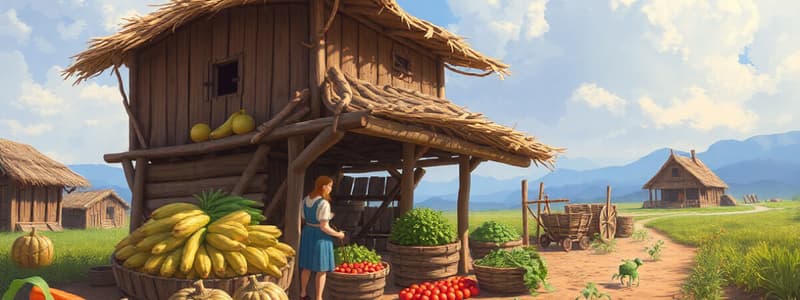Podcast
Questions and Answers
What is one major negative issue associated with factory farming of animals?
What is one major negative issue associated with factory farming of animals?
- Enhanced animal welfare
- Higher diseases pressure (correct)
- Reduced reliance on seed companies
- Increased biodiversity
Which practice is a principle of sustainable agriculture?
Which practice is a principle of sustainable agriculture?
- Extensive irrigation without technology
- Perennial polyculture (correct)
- Heavy use of chemical fertilizers
- Maximal tillage and monoculture
What is a potential consequence of genetic manipulation of crops?
What is a potential consequence of genetic manipulation of crops?
- Enhanced biodiversity
- Reduction of pest populations
- Improved nutrient uptake in all cases
- Increased reliance on seed companies (correct)
What does Integrated Pest Management (IPM) primarily emphasize?
What does Integrated Pest Management (IPM) primarily emphasize?
Which crop accounts for a significant proportion of the world's cropland?
Which crop accounts for a significant proportion of the world's cropland?
Why can genetic modification in organisms be problematic?
Why can genetic modification in organisms be problematic?
What is one advantage of localized food systems?
What is one advantage of localized food systems?
What negative issue is associated with the widespread use of chemical inputs in agriculture?
What negative issue is associated with the widespread use of chemical inputs in agriculture?
What was one primary goal of conventional agriculture that emerged in the 20th century?
What was one primary goal of conventional agriculture that emerged in the 20th century?
Which of the following practices is associated with intensive tillage?
Which of the following practices is associated with intensive tillage?
What is a negative issue associated with monoculture?
What is a negative issue associated with monoculture?
Which negative consequence is commonly linked to the use of inorganic fertilizers?
Which negative consequence is commonly linked to the use of inorganic fertilizers?
What does irrigation primarily aim to achieve in agricultural practices?
What does irrigation primarily aim to achieve in agricultural practices?
Which of the following is a characteristic of chemical pest control?
Which of the following is a characteristic of chemical pest control?
What is a potential impact of intensive tillage on the soil?
What is a potential impact of intensive tillage on the soil?
Which principle of conventional agriculture involves cultivating a single type of crop?
Which principle of conventional agriculture involves cultivating a single type of crop?
Flashcards are hidden until you start studying
Study Notes
Agriculture's Success in the 20th Century
- Yields per acre increased dramatically, food prices declined, and food production growth outpaced population growth, leading to a decrease in chronic hunger.
- This success was driven by advancements:
- New plant varieties
- Fertilizers and pesticides
- Technological advancements
- Irrigation expansion
Conventional Agriculture: Principles and Negative Impacts
- Conventional Agriculture emerged in the 20th century focusing on maximizing production and profits.
- It relies on seven key principles:
- Intensive Tillage:
- Deep and consistent soil cultivation, impacting soil structure and contributing to erosion, nutrient leaching, and compaction.
- Monoculture:
- Growing one or two crops on a large scale, making the ecosystem vulnerable to pests, disease, and financial stability.
- Irrigation:
- Water application for expanded farming, altering regional hydrology, requiring large infrastructure, and potentially leading to groundwater mining and leaching.
- Inorganic Fertilizer:
- Synthetic fertilizers developed during WW1, relying on fossil fuels and mining processes, impacting soil ecology, and contributing to water pollution.
- Chemical Pest Control:
- Pesticides, fungicides, and herbicides developed during WW2, causing ecological damage, disrupting beneficial insect populations, and posing risks to human health.
- Genetic Manipulation:
- Selective breeding and hybridization for desired traits, resulting in organisms with strengths and weaknesses, dependence on seed companies, reduced biodiversity, and potential genetic migration.
- Factory Farming (CAFOs):
- High animal density in confined spaces, raising concerns for animal welfare, disease outbreaks, genetic modification, and serious environmental impacts from waste management.
- Intensive Tillage:
Sustainable Agriculture: Principles and Practices
- Sustainable agriculture prioritizes equitable production and distribution of high-quality, affordable food while protecting and enhancing agricultural systems.
- It emphasizes environmentally friendly practices:
- Minimal Tillage and Mulching:
- Reduces soil disturbance, promotes soil health, and conserves soil moisture.
- Perennial Polyculture:
- Growing multiple crops in the same space, increasing biodiversity, and reducing the need for pesticides and fertilizers.
- Minimal Irrigation:
- Employing efficient irrigation technologies to optimize water usage.
- Localized Organic Fertility Systems:
- Improving soil health through organic matter and natural fertilization methods, reducing dependence on synthetic fertilizers.
- Integrated Pest Management (IPM):
- A comprehensive approach that combines various techniques to manage pests effectively with minimal environmental impact.
- Selection of Locally Adapted Plants and Animals:
- Utilizing species best suited to specific environments, promoting local biodiversity, and reducing vulnerability to pests and diseases.
- Localized Food Systems:
- Shortening the distance between production and consumption to reduce transport costs and environmental impact.
- Closed Nutrient Systems:
- Minimizing waste and maximizing nutrient cycling within the agricultural system.
- Local Place-Based Knowledge:
- Utilizing traditional knowledge and practices for sustainable agricultural practices.
- Eat Lower on the Food/Energy Pyramid:
- Shifting dietary preferences towards less resource-intensive food options.
- New Food Sources:
- Exploring alternative protein sources such as algae, fungi, yeast, and insects.
- Minimal Tillage and Mulching:
Studying That Suits You
Use AI to generate personalized quizzes and flashcards to suit your learning preferences.




